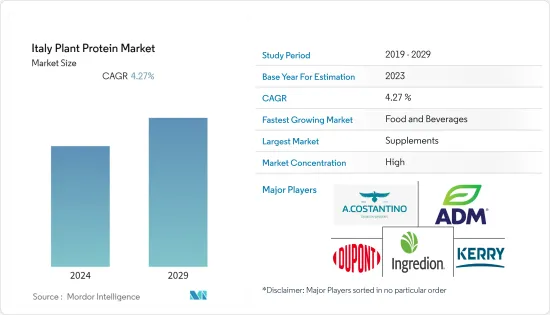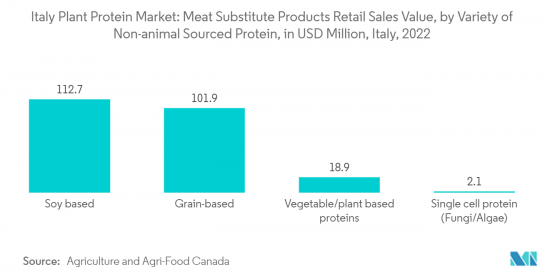PUBLISHER: Mordor Intelligence | PRODUCT CODE: 1406954

PUBLISHER: Mordor Intelligence | PRODUCT CODE: 1406954
Italy Plant Protein - Market Share Analysis, Industry Trends & Statistics, Growth Forecasts 2024 - 2029

The Italy plant protein market was valued at USD 205.4 million for the current year and is projected to register a CAGR of 4.27% over the next five years.
Key Highlights
- More environmentally sustainable and health-conscious consumers are turning to plant-based protein sources as an alternative to animal products. To increase their appeal to customers, the food industry is consistently trying to create new plant-based products that taste and feel like traditional animal-based foods.
- Moreover, there is an increase in consumers' inclination towards protein-rich food products. Therefore, manufacturers are launching innovative plant-protein products to address the changing needs of the industry. For instance, in April 2021, Ingredion Inc. launched two new ingredients under its plant-based pea protein segment. It launched Vitessense Pulse 1853 Pea Protein Isolate and Purity P 1002 Pea Starch, which are 100% sustainably sourced from North American farms.
- Additionally, the increase in demand for plant protein may also be attributed to government initiatives and public health campaigns that support sustainable and healthy eating. As a result, companies are opting for mergers and acquisitions as strategies to increase their market share and product presence.
- For instance, in February 2021, DuPont's Nutrition & Biosciences and the ingredient company IFF announced their merger. The combined company stated that it will continue to operate under the name IFF. The complementary portfolios give the company leadership positions within a range of ingredients, including soy protein. Thus, all the factors act as major market drivers for the Italian plant protein market.
Italy Plant Protein Market Trends
Growing Innovation in Food and Beverage Industry Especially in Vegan Meat Alternatives
- The food and beverage industry is one of the leading application sectors for plant protein in the region. Pea proteins are gaining huge demand from meat alternatives as they provide quick rehydration, neutral taste, and texturizing properties, leading to numerous product launches. For instance, according to the ITC Trade Map Trade statistics for international business development, the import value of peas in 2022 in Italy accounted for USD 75.76 million.
- The rising consumer focus on health and sports fitness is anticipated to drive the segment. The preference for soy in the supplements nutrition sector propels segmental growth. The increasing demand for protein functionalities, awareness about protein-rich diets, etc., primarily drive the demand for the protein market in food and beverage sector.
- The increase is mainly due to product innovations from manufacturers, the adoption rate of consumers toward healthier choices, and the increase in population, thus driving the sales of plant protein in the food and beverages industry. Hence, all the above-mentioned factors positively drive the market in this country.

Animal Feed End-user Segment Dominates the Market
- Soy protein is dominant among all plant protein types due to its high protein content, low viscosity, solubility, etc., which cater to extensive applications in all sectors. The F&B segment leads the market, majorly driven by the meat and dairy alternatives sectors. The wider use of soy proteins in the segment is further promoting growth. Manufacturers' cost-effective options are further encouraging feed companies to incorporate greater protein content in animal feed.
- Moreover, soy protein, mainly in the form of concentrates, is widely used in the diets of animals, birds, and fish. Its main characteristics, such as easy digestibility, improved shelf life, and protein enrichment, are driving its application in the other segments. As a result, Italy imports a significant amount of soy to extract soy protein. For instance, according to UN Comtrade, in 2022, the import value of soy flour in Italy accounted for USD 9.110 million, which is a significant increase from 2021, which accounted for USD 7.301 million.
Italy Plant Protein Industry Overview
The Italy plant protein market is highly fragmented. The major foreign players in the market are Costantino & C. SPA, Archer Daniels Midland Company, DuPont de Nemours Inc., Ingredion Incorporated, and Kerry Group PLC (sorted alphabetically). Further, the companies have been introducing new and innovative ingredients using plant proteins so as to make their product unique from the existing products. Owing to the rapidly developing nature of the market, new product innovation has become the most commonly used strategy among all, as it helps in understanding the changing needs of the various application industries in the market.
Additional Benefits:
- The market estimate (ME) sheet in Excel format
- 3 months of analyst support
TABLE OF CONTENTS
1 Executive Summary & Key Findings
2 INTRODUCTION
- 2.1 Study Assumptions and Market Definition
- 2.2 Scope of the Study
3 RESEARCH METHODOLOGY
4 EXECUTIVE SUMMARY
5 MARKET DYNAMICS
- 5.1 Market Drivers
- 5.1.1 Growing Innovation in Food and Beverage Industry especially in Vegan Meat Alternatives
- 5.1.2 Increasing Inclination Towards Plant-based Food and Beverage Products
- 5.2 Market Restraints
- 5.2.1 Competition from Substitute Products Available at Affordable Prices
- 5.3 Porter's Five Forces Analysis
- 5.3.1 Bargaining Power of Suppliers
- 5.3.2 Bargaining Power of Buyers/Consumers
- 5.3.3 Threat of New Entrants
- 5.3.4 Threat of Substitute Products
- 5.3.5 Intensity of Competitive Rivalry
6 Market Segmentation
- 6.1 Protein Type
- 6.1.1 Hemp Protein
- 6.1.2 Oat Protein
- 6.1.3 Pea Protein
- 6.1.4 Potato Protein
- 6.1.5 Rice Protein
- 6.1.6 Soy Protein
- 6.1.7 Wheat Protein
- 6.1.8 Other Plant Protein
- 6.2 End-User
- 6.2.1 Animal Feed
- 6.2.2 Personal Care and Cosmetics
- 6.2.3 Food and Beverages
- 6.2.3.1 Bakery
- 6.2.3.2 Beverages
- 6.2.3.3 Breakfast Cereals
- 6.2.3.4 Condiments/Sauces
- 6.2.3.5 Confectionery
- 6.2.3.6 Dairy and Dairy Alternative Products
- 6.2.3.7 Meat/Poultry/Seafood and Meat Alternative Products
- 6.2.3.8 RTE/RTC Food Products
- 6.2.3.9 Snacks
- 6.2.4 Supplements
- 6.2.4.1 Baby Food and Infant Formula
- 6.2.4.2 Elderly Nutrition and Medical Nutrition
- 6.2.4.3 Sport/Performance Nutrition
7 Competitive Landscape
- 7.1 Most Adopted Strategies
- 7.2 Market Share Analysis
- 7.3 Company Profiles
- 7.3.1 A. Costantino & C. spa
- 7.3.2 Archer Daniels Midland Company
- 7.3.3 Brenntag SE
- 7.3.4 Cargill, Incorporated
- 7.3.5 DuPont de Nemours Inc.
- 7.3.6 Ingredion Incorporated
- 7.3.7 Kerry Group PLC
- 7.3.8 Roquette Freres
- 7.3.9 The Scoular Company
- 7.3.10 Cargill
8 MARKET OPPORTUNITIES AND FUTURE TRENDS




